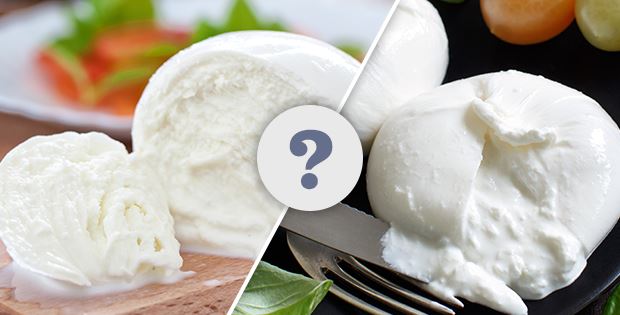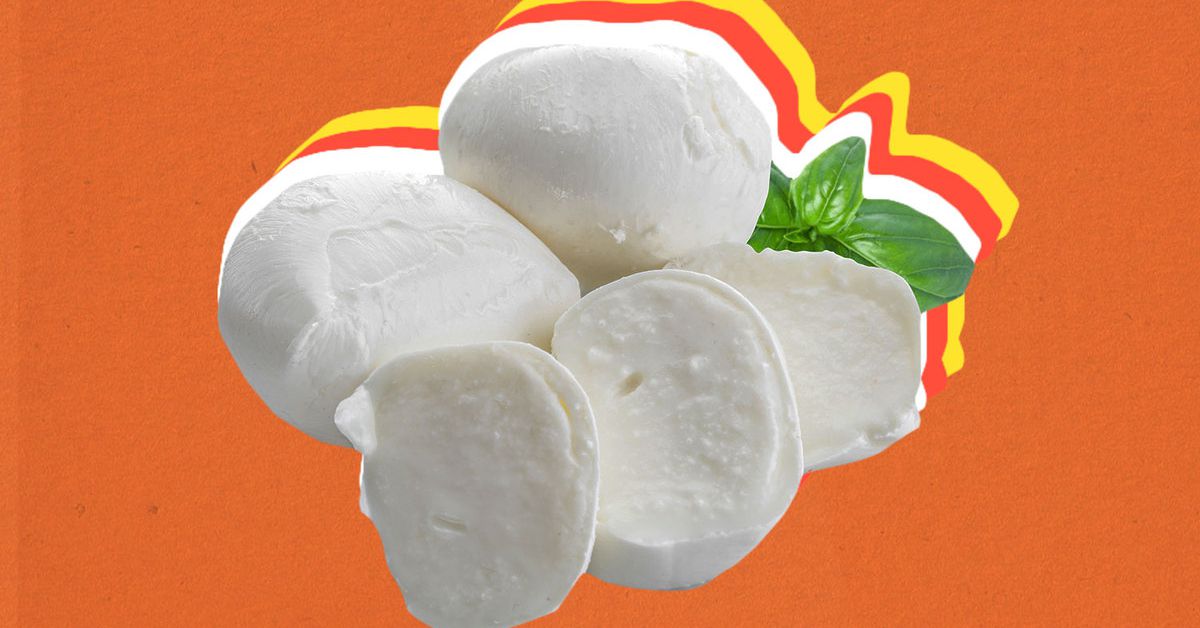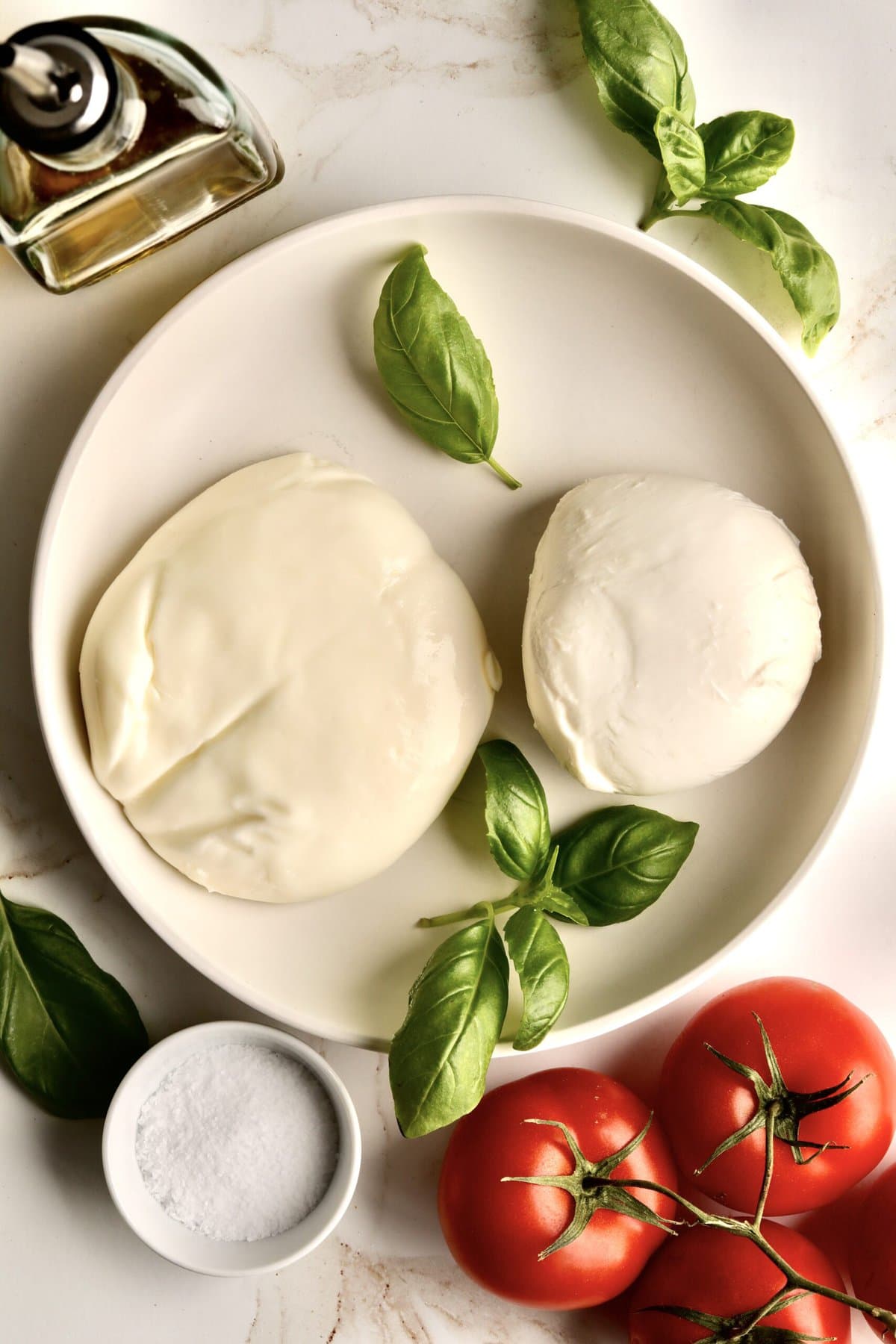Introduction

When it comes to creamy cheeses, Burrata and Mozzarella are two popular options that often confuse food enthusiasts. While they may share similarities, they have distinct characteristics and flavors that set them apart. Burrata is known for its rich and creamy interior, while Mozzarella has a more delicate taste and a slightly elastic texture. Understanding the differences between these cheeses will help you make informed choices when using them in various recipes. In this article, we will explore the characteristics, production methods, taste, texture, and culinary uses of Burrata and Mozzarella.
Overview Of Burrata Cheese And Mozzarella
Burrata Cheese and Mozzarella are both popular creamy cheeses with distinct characteristics. Burrata is known for its rich and creamy interior, while Mozzarella has a more delicate taste and slightly elastic texture. Both cheeses originate from Italy and are made from cow or water buffalo milk. Burrata is unique as it is formed into a pouch and filled with soft stringy curd and cream. Mozzarella is typically shaped into balls or blocks. These cheeses are versatile and can be used in various culinary creations, adding a delicious creamy element to dishes.
History And Origin Of The Cheeses
Burrata cheese and mozzarella have deep roots in Italian culinary traditions. Mozzarella can be traced back to ancient Rome, where a similar cheese made from sheep’s milk was produced as early as the first century A.D. Over time, the recipe evolved to include cow’s milk as well. Burrata cheese, on the other hand, has a more recent origin. It is believed to have been created in the 20th century in the Apulia region of Southern Italy. Today, both cheeses are beloved for their unique flavors and textures, and they continue to be cherished staples in Italian cuisine.
Burrata Cheese

Burrata cheese is a popular Italian cheese known for its creamy and indulgent flavor. It is made by shaping mozzarella cheese into a pouch and filling it with a combination of soft, stringy curd and cream. This unique combination gives burrata its distinctive texture and richness. When cut open, burrata releases a creamy center that oozes out, making it a delight to eat. It is often enjoyed fresh, paired with ripe tomatoes and basil, or drizzled with olive oil and balsamic vinegar for a simple yet delicious appetizer or salad.
Characteristics And Appearance Of Burrata
Burrata cheese is known for its unique characteristics and appearance. It is a soft, fresh cheese that has a creamy and indulgent flavor. Its exterior is smooth and white, similar to fresh mozzarella. However, what sets burrata apart is its interior. When cut open, burrata reveals a creamy center that oozes out, making it incredibly rich and decadent. The combination of the soft, stringy curd and cream creates a luscious texture that melts in the mouth. This creamy center is surrounded by a thin shell of mozzarella, giving burrata its distinctive pouch-like shape. It is a visually striking cheese that is as beautiful as it is delicious.
How Burrata Is Produced
Burrata cheese is produced through a multi-step process that requires skill and precision. First, fresh mozzarella cheese is made by heating and stretching the curd obtained from cow’s milk. Next, the mozzarella curd is formed into a pouch-like shape and filled with a mixture of cream and soft, stringy curd. The opening is then sealed, ensuring that the creamy filling remains intact. Finally, the burrata is immersed in cool, salted water to enhance its flavor and preserve its freshness. This careful production method results in the unique and luxurious texture of burrata cheese.
Mozzarella

Mozzarella is a traditional Italian cheese that is widely recognized for its smooth texture and mild flavor. It is typically made from cow’s milk, although buffalo milk is also used in traditional production. Mozzarella is known for its white color and elastic consistency, which allows it to stretch and melt beautifully when heated. The cheese is commonly used in dishes such as pizza, caprese salad, and grilled cheese sandwiches. Mozzarella is often enjoyed in its fresh, soft form, but it can also be aged to develop a firmer texture and stronger flavor.
Characteristics And Appearance Of Mozzarella
Mozzarella is known for its smooth texture and mild flavor. It has a soft and elastic consistency, allowing it to stretch and melt beautifully when heated. The cheese is typically white in color and has a shiny, glossy appearance. Mozzarella is usually shaped into balls or small cylinders, and can also be found in larger sizes for slicing or shredding. Its appearance is creamy and luscious, making it an appealing ingredient in dishes such as pizza, caprese salad, and pasta. Mozzarella adds a touch of richness and creaminess to any dish it is used in.
Traditional Methods Of Making Mozzarella
Traditional methods of making Mozzarella involve the use of fresh buffalo or cow’s milk. The milk is heated and acidified, usually with the addition of citric acid or starter cultures. This causes the milk to coagulate and form curds. The curds are then cut into small pieces and heated again to expel the whey. The curds are then stretched and kneaded by hand or using special machinery to develop the characteristic smooth and elastic texture of Mozzarella. Finally, the Mozzarella is shaped into balls or cylinders and immersed in brine to enhance its flavor and preservation. This traditional process ensures the authentic taste and quality of Mozzarella cheese.
Taste And Texture

Differences in taste between Burrata and Mozzarella are quite distinct. Burrata has a richer and more intense flavor, thanks to its creamy center made from stracciatella and cream. It offers a combination of creamy, milky, and slightly tangy notes. On the other hand, Mozzarella has a milder and more delicate taste with a hint of sweetness. The texture of Burrata is exceptionally soft and creamy, while Mozzarella has a smoother, stretchy, and chewy texture. Both cheeses have their unique appeal and can be enjoyed in a variety of culinary creations.
Differences In Taste Between Burrata And Mozzarella
Burrata and Mozzarella have distinct differences in taste. Burrata offers a richer and more intense flavor profile compared to Mozzarella. This is due to the creamy center made from stracciatella and cream in Burrata. It provides a combination of creamy, milky, and slightly tangy notes. In contrast, Mozzarella has a milder and more delicate taste with a hint of sweetness. Whether you prefer the decadent richness of Burrata or the subtle sweetness of Mozzarella, both cheeses offer unique flavors that can enhance a variety of dishes.
Texture Variations Of The Cheeses
Burrata and Mozzarella have distinct texture variations that contribute to their unique qualities. Burrata is known for its soft and creamy texture, with a delicate outer layer and a rich, smooth center. This combination of textures provides a luxurious and indulgent eating experience. In contrast, Mozzarella has a more elastic and stretchy texture. It is slightly firmer and has a more springy bite, making it ideal for melting and stretching. Whether you prefer the velvety softness of Burrata or the stretchy texture of Mozzarella, both cheeses offer pleasurable experiences for cheese lovers.
Culinary Uses

Culinary Uses: Burrata is a versatile cheese that can be enjoyed in a variety of ways. Its creamy texture and rich flavor make it a perfect addition to salads, pasta dishes, and pizzas. Burrata can also be served as an appetizer, paired with ripe tomatoes or prosciutto for a decadent and elegant dish.
On the other hand, Mozzarella is a staple in Italian cuisine and is commonly used in dishes such as Caprese salad, lasagna, and pizza. Its stretchy texture and mild flavor make it ideal for melting and grilling.
Both cheeses can be enjoyed on their own or incorporated into a wide range of recipes, adding a delicious and creamy touch to any dish.
Popular Dishes That Include Burrata
Burrata is a versatile cheese that can be enjoyed in a variety of ways. Its creamy texture and rich flavor make it a perfect addition to salads, pasta dishes, and pizzas. Burrata can also be served as an appetizer, paired with ripe tomatoes or prosciutto for a decadent and elegant dish. It can be incorporated into sandwiches, bruschetta, or even used as a filling for stuffed meats or vegetables. The possibilities are endless, as Burrata adds a luxurious and creamy touch to any dish.
Traditional And Creative Uses Of Mozzarella
Mozzarella is widely known for its versatility in traditional Italian cuisine. It is a key ingredient in classics such as Caprese salad, Margherita pizza, and lasagna. Its mild and creamy flavor pairs well with tomatoes, basil, and olive oil.
Beyond the traditional uses, Mozzarella can also be incorporated into creative dishes. It can be stuffed into meatballs or used as a filling for stuffed vegetables. Mozzarella sticks are a popular snack, and it can be breaded and fried to create a crunchy outer layer. It can also be melted and used as a topping for burgers, sandwiches, or even in desserts like cheesecake. The possibilities are endless when it comes to exploring the culinary uses of Mozzarella.
Conclusion

In conclusion, understanding the differences and similarities between Burrata Cheese and Mozzarella is essential for any culinary enthusiast or chef. While both cheeses share a similar base, Burrata stands out with its creamy center and delicate flavor, making it an excellent choice for dishes that require a touch of luxury. Mozzarella, on the other hand, excels in its versatility and ability to melt and stretch, making it perfect for traditional Italian dishes. By exploring these cheeses’ unique characteristics, textures, and tastes, chefs can elevate their culinary creations and delight their taste buds. Next time you’re in the kitchen, choose the right cheese based on your desired flavor and texture to create an unforgettable dining experience.
Key Differences Between Burrata Cheese And Mozzarella
Burrata Cheese and Mozzarella have several key differences that set them apart.
- Texture: Burrata has a soft and creamy texture, with a delicate outer shell and a rich, creamy center. Mozzarella, on the other hand, has a more elastic texture and a firmer consistency.
- Taste: Burrata has a more pronounced and indulgent flavor due to the creamy center, while Mozzarella has a milder and more subtle taste.
- Composition: Burrata is made from mozzarella cheese that is formed into a pouch and filled with a combination of soft curd and cream. Mozzarella is made from stretched curds of fresh milk.
- Culinary uses: Burrata is often enjoyed on its own or served with salads, pastas, and pizzas to add a luxurious touch. Mozzarella is widely used in pizza, lasagna, caprese salads, and other traditional Italian dishes.
Overall, while both cheeses share a similar base, Burrata stands out with its creamy center and delicate flavor, making it a more luxurious and indulgent choice.
Tips On Choosing The Right Cheese For Different Recipes
When it comes to choosing the right cheese for different recipes, there are a few tips to keep in mind. First, consider the flavor profile you’re aiming for. If you want a rich and creamy taste, opt for Burrata. For a more mild and subtle flavor, go for Mozzarella.
Next, consider the texture you want in your dish. Burrata’s creamy center adds a luxurious touch, while Mozzarella’s elasticity works well in dishes like pizza and lasagna.
Lastly, consider the melting properties of the cheese. Mozzarella melts beautifully, making it ideal for dishes that require a gooey, melted cheese texture.
By keeping these tips in mind, you can choose the right cheese to elevate your recipes to new heights.
Frequently Asked Questions: Burrata Cheese vs Mozzarella
Q: What is the main difference between burrata cheese and mozzarella?
A: While both burrata and mozzarella cheese originate in Italy and are made from cow’s milk, their main difference lies in their texture and flavor. Burrata is a soft, creamy cheese with a delicate outer shell and a rich, creamy center, while mozzarella has a firmer and more elastic texture.
Q: How is burrata cheese different from mozzarella in terms of production?
A: Both burrata and mozzarella are typically made from the curds of fresh cow’s milk. However, burrata is created through a special technique where cream is added to the center of the mozzarella, creating a soft and creamy interior. This gives burrata its unique and luxurious texture.
Q: Can I use burrata as a substitute for mozzarella in recipes?
A: While burrata and mozzarella are similar in terms of their taste profile and origin, they have distinct textures. Burrata’s soft and creamy consistency makes it a delightful addition to salads, pastas, or as a spread on crusty bread. However, it may not melt or stretch like mozzarella does, so it might not work as a direct substitute in some recipes.
Q: How should I store burrata and mozzarella?
A: Both burrata and mozzarella should be stored in the refrigerator. However, it is important to note that burrata has a shorter shelf life and is best consumed within a few days of purchase, as its cream-filled center can spoil quickly. Mozzarella, on the other hand, can be stored for a longer period if properly sealed.
Q: Are there any variations of burrata and mozzarella available?
A: Yes, there are variations of both burrata and mozzarella cheese. Burrata can be found in different flavors such as truffle-infused, herb-infused, or with added ingredients like sun-dried tomatoes or olives. Mozzarella also comes in different forms, including fresh mozzarella balls, smoked mozzarella, or low-moisture mozzarella for pizza.
Q: Can I freeze burrata or mozzarella cheese?
A: While it is possible to freeze both burrata and mozzarella cheese, it is generally not recommended, as freezing can alter their texture and affect their taste. Freezing can cause the cheese to become watery and lose its original creamy or stretchy consistency. It is best to consume these cheeses fresh for the best flavor and texture.
Q: Which cheese is better for caprese salad, burrata, or mozzarella?
A: Both burrata and mozzarella can be used in a caprese salad, but they offer different experiences. Traditional caprese salads usually feature fresh mozzarella, as its firmer texture holds its shape better. However, if you prefer a creamier and more indulgent salad, burrata is an excellent choice. Its luscious center adds a luxurious touch to the classic combination of tomatoes, basil, and olive oil.
Q: Can lactose-intolerant individuals consume burrata or mozzarella cheese?
A: Lactose content varies in different types of cheese. While mozzarella and burrata do contain lactose, some individuals with lactose intolerance may be able to tolerate small amounts of these cheeses due to the fermentation process involved in their production. However, it is best to consult a healthcare professional to determine individual tolerance levels.
Q: Is burrata cheese more expensive than mozzarella cheese?
A: Generally, burrata cheese tends to be more expensive than mozzarella. The added effort and time required to produce the delicate cream-filled center contribute to its higher cost. Mozzarella, being more widely available, is often more affordable. However, prices may vary depending on the quality, brand, and region where the cheeses are purchased.

From At-Home Dinner Parties to Family Reunions to Office Parties, we can cater your next Event!